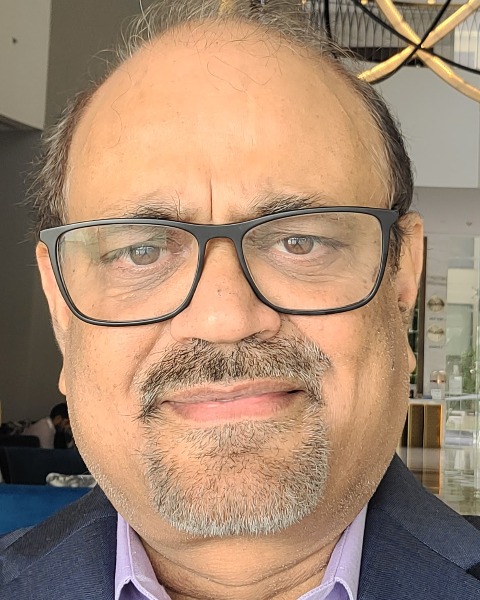Networking
Smart Manufacturing
Smart Manufacturing Reception and Live Poster Session
Digitizing a Functional Fabrication Plant for a Digital Twin Future
Wednesday, October 8, 2025
5:15pm - 6:30pm MT
Location: Smart Manufacturing Pavilion Theater, North Building, Lower Level, Expo Floor

Thenkurussi 'Kesh' Kesavadas
Vice President for Research and Economic
University at Albany, SUNY
Albany, NY, United States
Poster Presenter (SMfG)(s)
Crafting a resilient future for semiconductor manufacturing hinges on the seamless integration of the physical and digital realms. The digital twin concept offers a powerful paradigm for this transformation, serving as a dynamic virtual replica of a semiconductor fabrication facility (fab). This intelligent representation encompasses not just the physical layout and equipment but also the intricate processes, material flows, operational data, energy utilization models and even the implicit knowledge held by experienced personnel. By aggregating data from disparate sources – existing fabrication plans, diverse databases, real-time machine sensor readings, and more – a comprehensive and living model of the fab can be created.
This digital twin unlocks a multitude of transformative capabilities. Running "what-if" scenarios to optimize production schedules, predict potential bottlenecks before they occur, and evaluate the impact of equipment upgrades or process modifications – all within a risk-free virtual environment. The digital twin also revolutionizes the design of new semiconductor plants. By leveraging the insights gleaned from the virtual representation of existing fabs, engineers can simulate different layouts, optimize resource allocation, and proactively identify potential design flaws, leading to more efficient and cost-effective greenfield deployments. Further, digital twin can become an archive of a company’s knowledge and intellectual property.
Furthermore, the digital twin provides an unparalleled platform for workforce training. New technicians and engineers can immerse themselves in a realistic virtual fab environment, learning complex procedures, troubleshooting equipment malfunctions, and gaining hands-on experience without disrupting actual production for not just an hypothetical plan but an existing plant.
The journey to building a comprehensive semiconductor digital twin presents significant challenges, particularly in creating the foundational models. Starting from scratch to develop accurate 3D models of complex machinery and meticulously capturing intricate fabrication processes can be resource-intensive and time-consuming. To address this, we are exploring innovative approaches to leverage existing knowledge. One promising avenue involves converting existing 2D and potentially rudimentary 3D models into richer, more detailed virtual representations through the capture and processing of 3D point clouds of existing machines and fabs. Another approach investigates the merging of augmented reality (AR) models, allowing for the integration of both existing and newly designed 3D assets into a cohesive virtual environment. Additionally, we are exploring the use of data warehouses to extract valuable process knowledge and operational patterns that can inform the behavior and logic of the digital twin.
To rigorously test and validate the digital twin concept in a real-world setting, we are undertaking a comprehensive initiative to convert the University at Albany’s College of Nanotechnology, Science, and Engineering (CNSE) 200 mm semiconductor fabrication line into a fully functional digital twin. This endeavor involves capturing the intricacies of several critical machines and integrating diverse data streams. We are leveraging the AirVu platform and AirGen software from AirV Labs, which employs artificial intelligence (AI) to accelerate the creation of digital models. This pilot project will serve as demonstration implementation strategies for converting an existing fab to into a digital twin.
This digital twin unlocks a multitude of transformative capabilities. Running "what-if" scenarios to optimize production schedules, predict potential bottlenecks before they occur, and evaluate the impact of equipment upgrades or process modifications – all within a risk-free virtual environment. The digital twin also revolutionizes the design of new semiconductor plants. By leveraging the insights gleaned from the virtual representation of existing fabs, engineers can simulate different layouts, optimize resource allocation, and proactively identify potential design flaws, leading to more efficient and cost-effective greenfield deployments. Further, digital twin can become an archive of a company’s knowledge and intellectual property.
Furthermore, the digital twin provides an unparalleled platform for workforce training. New technicians and engineers can immerse themselves in a realistic virtual fab environment, learning complex procedures, troubleshooting equipment malfunctions, and gaining hands-on experience without disrupting actual production for not just an hypothetical plan but an existing plant.
The journey to building a comprehensive semiconductor digital twin presents significant challenges, particularly in creating the foundational models. Starting from scratch to develop accurate 3D models of complex machinery and meticulously capturing intricate fabrication processes can be resource-intensive and time-consuming. To address this, we are exploring innovative approaches to leverage existing knowledge. One promising avenue involves converting existing 2D and potentially rudimentary 3D models into richer, more detailed virtual representations through the capture and processing of 3D point clouds of existing machines and fabs. Another approach investigates the merging of augmented reality (AR) models, allowing for the integration of both existing and newly designed 3D assets into a cohesive virtual environment. Additionally, we are exploring the use of data warehouses to extract valuable process knowledge and operational patterns that can inform the behavior and logic of the digital twin.
To rigorously test and validate the digital twin concept in a real-world setting, we are undertaking a comprehensive initiative to convert the University at Albany’s College of Nanotechnology, Science, and Engineering (CNSE) 200 mm semiconductor fabrication line into a fully functional digital twin. This endeavor involves capturing the intricacies of several critical machines and integrating diverse data streams. We are leveraging the AirVu platform and AirGen software from AirV Labs, which employs artificial intelligence (AI) to accelerate the creation of digital models. This pilot project will serve as demonstration implementation strategies for converting an existing fab to into a digital twin.
